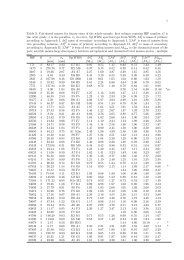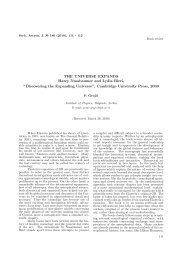V. BÖHM et al.2. TESTS WITH SOLAR ECLIPSESThere is a list <strong>of</strong> predicted solar eclipsesrecorded on pp. D 30 – D 37 (F 51 – F 58) <strong>of</strong> the DC;the initial Mayan date <strong>of</strong> the solar eclipse 9.16.4.10.812 Lamat (LC=1 412 848) is followed by 69 cycles(each comprising 177, 178 or 148 days), reflecting thedates <strong>of</strong> the next expected eclipses. Quite naturally,only some <strong>of</strong> them were observable in Yucatan, mostrefer to the ones occurring at other places on theEarth. The table begins and ends by the same Mayandate, 12 Lamat, and covers altogether 11 960 days(i.e., 405 synodic months, 439.5 draconic months and46 tzolkin cycles <strong>of</strong> 260 days). The uncertainty <strong>of</strong> theprediction (±1 day) is expressed by three consecutivedates in each case. The list <strong>of</strong> all these 70 eclipsesis reproduced in Table 4. We tested them againstall eclipses that really occurred somewhere on theEarth and found that there is a group <strong>of</strong> correlationswith 59 or more successful predictions: Teeple(66), Vollemaere 1 (66), Weitzel (66), Kelley 1 (65),Wells and Fuls (60), Escalone (60), B&B (59), Vollemaere2 (59). Out <strong>of</strong> these, Weitzel, Vollemaere 1and Vollemaere 2 correlations are practically identical(they agree within two days). On the otherhand, GMT predicted only 4 <strong>of</strong> them. It is notzero just by a chance due to the fact that we workwith the short-<strong>periodic</strong> phenomenon (typical <strong>periodic</strong>ity<strong>of</strong> the eclipses is 177 days, the range is 148–178days). When similar tests were made against theeclipses visible only in Yucatan, the best scored oneswere: B&B (8), Pogo and Hochleitner (7), Willsonand Teeple (6). Thus the B&B correlation seems toyield the best agreement.3. TESTS WITH LONG-PERIODICASTRONOMICAL PHENOMENAFor a unique determination <strong>of</strong> τ we need anon-<strong>periodic</strong> phenomenon, but there is nothing likethat in the DC or another Maya source. But there isa synchrony <strong>of</strong> the dates <strong>of</strong> heliacal risings/settings<strong>of</strong> Venus with the Sun’s eclipses, or between conjunctions<strong>of</strong> two planets and the solar eclipses – coincidencebetween two short-<strong>periodic</strong> phenomena whichis itself <strong>of</strong> <strong>long</strong>- <strong>periodic</strong> character. By synchronywe mean here the situation when there exists in theDC a time interval between two recorded dates thatcontains integer numbers <strong>of</strong> periods <strong>of</strong> different <strong>astronomical</strong>phenomena. Such synchronies are rareand can simulate <strong>long</strong>-<strong>periodic</strong> phenomena. Fortunately,we were able to decode such data from theDC so that we will utilize them now.3.1 Synchrony in the DC <strong>of</strong> Venusian heliacalrisings with solar eclipsesLet us use the date 9.16.4.10.8 12 Lamat, correspondingto LC = 1 412 848. It points to the firstsolar eclipse in the series <strong>of</strong> eclipses in the DC, whichis accepted by nearly all investigators; see pages D 30– 37 (F 51 – 58), e.g. Klokočník et al. (2008). Nowwe look for the second useful date. Page D 24 (F 24)<strong>of</strong> DC contains the date 9.9.9.16.0 1 Ahau 18 Kayab,which corresponds to LC = 1 364 360. On that dayVenus was first seen, according to the Maya, as theMorning Star after its inferior conjunction with theSun. This was also the first date for determination<strong>of</strong> further heliacal risings <strong>of</strong> Venus (added to thisdate are various multiples <strong>of</strong> the cycle <strong>of</strong> 2 920 days).This interval is the basic <strong>periodic</strong>ity <strong>of</strong> overlappingVenusian synodic and sidereal orbits with the tropicalyear after which Venus rises or sets every 8 yearsin approximately the same place in the sky.Thus we have two LC dates, 1 412 848 and1 364 360, marking two different <strong>astronomical</strong> phenomenavisible in the Mayan sky. It is evidentthat the time interval between these two phenomena,∆ = 48 488 days, must be the same as the timeinterval actually existing “in the nature”. If we takeboth these Mayan dates and attempt to apply theindividual correlations, then the correct correlationmust yield the same time interval ∆ as was actuallyobserved between the heliacal rising <strong>of</strong> Venus and thesolar eclipse.We tested all the correlations from Table 1.For 39 correlations, we have got no solar eclipse forLC = 1 412 848, while 12 correlations did correspondto solar eclipses but none was visible in the Mayanregion. Apart from B&B, only Teeple’s correlation(τ = 492 622) gave a date when there was a solareclipse visible to the Maya (November 22, 504) butat the maximum <strong>of</strong> this eclipse, only 12% <strong>of</strong> the solardisc was obscured. However, for the second date(LC = 1 364 360), the heliacal rising <strong>of</strong> Venus did notoccur; the date corresponding to Teeple’s correlationfell on February 21, 372 when Venus was at inferiorconjunction and so not visible at all.We took into account all eclipses that were observablein the Mayan region in the period from June428 to August 1011; just 207 solar eclipses occurred.For each date <strong>of</strong> an eclipse, we subtracted the value∆ and checked if the date found coincided with aheliacal rising <strong>of</strong> Venus (there were 365 <strong>of</strong> them betweenMay 295 and December 878). Only the pronouncedsolar eclipse (85%) <strong>of</strong> October 29, 859 andonly the heliacal rising <strong>of</strong> Venus 48 488 days beforeit (January 27, 727) fulfil the condition <strong>of</strong> the synchrony.These dates coincide with LC <strong>dating</strong> only ifthe B&B correlation is used, from all τ’s in Table 1.So, the analysis <strong>of</strong> the synchrony <strong>of</strong> the solareclipses with heliacal rises <strong>of</strong> Venus speaks clearly:none but one <strong>of</strong> today known 52 correlations (accordingto Table 1), including the GMT, can be used toconvert the Maya dates to our <strong>calendar</strong>. The onlyexception is the B&B correlation. With it, the resultlooks like this:9.9.9.16.0 1 Ahau 18 Kayab = 1 364 360 +622 261 = 1 986 621 JD = January 27, 727.Heliacal rising <strong>of</strong> Venus occurred, eight daysafter inferior conjunction with the Sun.9.16.4.10.8 12 Lamat = 1 412 848 + 622 261 =2 035 109 JD = October 29, 859.The solar eclipse occurred in the Maya area,maximum magnitude was 85%.56
DATING OF MAYAN CALENDAR3.2 Synchrony <strong>of</strong> Venus and Marsconjunctions with solar eclipsesSimilarly to the Venusian heliacal aspects,there is a synchrony between Venus and Mars conjunctionswith the solar eclipses. By this, we meanthe situation when the solar eclipse is followed by aconjunction <strong>of</strong> Venus with Mars after 13 512 days.This occurred in Mayan history only once. It is necessaryto say that the average time interval betweenthe conjunctions is 234 days, but in reality the individualintervals can vary between 200 and 300 days,and sometimes they can even exceed 700 days (whentwo conjunctions do not really occur, and the twoplanets move in parallel several degrees apart).We start again with the same ‘initial’ solareclipse date 9.16.4.10.8 12 Lamat, LC = 1 412 848,recorded on p. D 31 (F 52) <strong>of</strong> DC. Other importantdates can be found on p. D 37 (F 58):9.18.2.2.0 4 Ahau (LC = 1 426 360), with the timedifference from the preceding one equal to 13 512days, that is accompanied by 9.12.11.11.0 4 Ahau(LC = 1 386 580), and also by a time interval 12.11(251 days), in which the number 11 is surrounded bya frame (a glyph <strong>of</strong> minus sign). The difference betweenthe two dates is equal to 39 780 days, i.e. 170times the average interval between two conjunctions<strong>of</strong> Venus with Mars. If we subtract 251 days (againclose to the interval between the two conjunctions)from the first above mentioned date, we get 9.18.1.7.913 Muluc (whose last part, 13 Muluc, is also recordedthere), corresponding to LC = 1 426 109. So, we canassume that all three LC dates (1 386 580, 1 426 109and 1 426 360) recorded on this page refer to the samephenomenon, conjunction <strong>of</strong> Venus with Mars.Next we tested all correlations from Table 1 t<strong>of</strong>ind which ones are capable <strong>of</strong> identifying all four LCdates (one for the eclipse, three for the conjunctions)with real phenomena. The only one that can assurethis with sufficient accuracy is the B&B correlation:phenom. LC B&B date Comp. dateconj. 1 386 580 Nov 28, 787 Nov 25, 787ecl. 1 412 848 Oct 29, 859 Oct 29, 859conj. 1 426 109 Feb 18, 896 Feb 16, 896conj. 1 426 360 Oct 26, 896 Oct 24, 896Small differences in the dates <strong>of</strong> conjunctions arefully acceptable, since these phenomena proceed veryslowly and the Mayan observations with naked eyecould not achieve better accuracy than a few days.3.3 Repeated conjunctions <strong>of</strong> Jupiter andSaturnConjunctions <strong>of</strong> Jupiter and Saturn repeat onthe average approximately every 19.6 years. At leastafter 40 years a situation occurs when two conjunctionscome shortly one after the other. This is the‘synchronization’ that is interesting from our point <strong>of</strong>view. Consequently, we were looking for two dates inDC differing by a multiple <strong>of</strong> 40 years (14 560 days).We found interesting complex information, consisting<strong>of</strong> two Mayan dates and an accompanying table,on page D 74 (F 45) <strong>of</strong> the DC. This allows to beinterpreted as referring to repeated conjunctions <strong>of</strong>Jupiter and Saturn.On page D 74, there are two Mayan dates inthe system <strong>of</strong> Long Count (LC) which correspond,after corresponding re-calculation, to the followingnumber <strong>of</strong> days in decimal expression:A) 8.17.11.3.0 4 Ahau 1 278 420−1.10 −30B) (8.17.11.1.10) 13 Oc 1 278 390The date B is not given directly in LC, but only bythe date 13 Oc <strong>of</strong> 260-day tzolkin cycle; missing digits<strong>of</strong> LC are given in parentheses. It can be calculatedby subtracting 30 days (accompanied by a minus signhieroglyph) from the date A. This way <strong>of</strong> calculatingthe next date by subtracting certain number <strong>of</strong> daysfrom the initial date is quite usual in DC. New dateis sometimes not expressed by all digits <strong>of</strong> LC, butonly by the final date <strong>of</strong> 260-day cycle (in this case13 Oc). On the same page <strong>of</strong> DC below the date B,there is an accompanying table, containing time intervals.The text in DC is partly damaged, but it ispossible to reconstruct it and prove that the individualitems represent multiples <strong>of</strong> 364 and 260 days, asexplained in Table 2.Table 2. Mayan table <strong>of</strong> page D 74 (F 45) <strong>of</strong> DresdenCodexMayan record Analysis <strong>of</strong> the table<strong>of</strong> time interval days ×364d ×260d?.?.8 13 Etznab 728 23.0.12 13 Ik 1092 34.0.15 13 Cimi 1456 45.1.0 13 Oc 1820 5 710.2.0 13 Oc 3640 10 1415.3.0 13 Oc 5460 15 21?.?.8.0 13 Oc 14560 40 56?.0.12.0 13 Oc 21840 60 844.0.16.0 13 Oc 29120 80 112The first column contains the original Mayaninscription; the missing numbers are replaced byquestion marks. Reconstructed time intervals in daysare shown in column two, columns three and fourgive multiples <strong>of</strong> 364 (that appears <strong>of</strong>ten in the tables<strong>of</strong> DC) and 260, respectively. Especially importantis the 80-year cycle (29 120 days) in the last row<strong>of</strong> Table 3. It contains 73 synodic periods <strong>of</strong> Jupiter(398.884 days), 77 synodic periods <strong>of</strong> Saturn (378.091days) and 112 tzolkin cycles (260 days). We can assumethat it is also the average interval between twoconjunctions <strong>of</strong> both planets. The initial point is thedate B, to which we should add the interval <strong>of</strong> 29 120days to obtain the next conjunction date C:B) (8.17.11.1.10) 13 Oc 1 278 390+4.0.16.0 13 Oc +29 120C) (9.1.11.17.10) 13 Oc 1 307 51057







